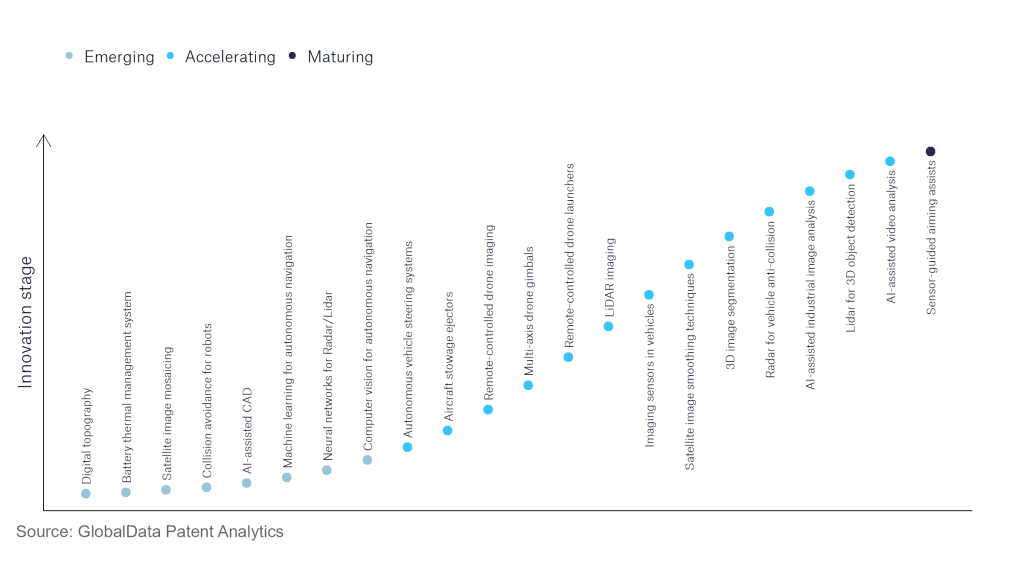The aerospace and defence industry continues to be a hotbed of innovation, with activity driven by developments in artificial technology and machine learning, and growing importance of technologies such as drones, satellite technology and big data. In the last three years alone, there have been over 174,000 patents filed and granted in the aerospace and defence industry, according to GlobalData’s report on Artificial Intelligence in Aerospace, Defence & Security: Remote-controlled drone imaging. Buy the report here.
However, not all innovations are equal and nor do they follow a constant upward trend. Instead, their evolution takes the form of an S-shaped curve that reflects their typical lifecycle from early emergence to accelerating adoption, before finally stabilising and reaching maturity.
Identifying where a particular innovation is on this journey, especially those that are in the emerging and accelerating stages, is essential for understanding their current level of adoption and the likely future trajectory and impact they will have.
180+ innovations will shape the aerospace and defence industry
According to GlobalData’s Technology Foresights, which plots the S-curve for the aerospace and defence industry using innovation intensity models built on over 262,000 patents, there are 180+ innovation areas that will shape the future of the industry.
Within the emerging innovation stage, machine learning for autonomous navigation, battery thermal management system, and satellite image mosaicing are disruptive technologies that are in the early stages of application and should be tracked closely. 3D image segmentation, AV on-board control systems, and lidar for 3D object detection are some of the accelerating innovation areas, where adoption has been steadily increasing. Among maturing innovation areas is sensor-guided aiming assists, which is now well established in the industry.
Innovation S-curve for artificial intelligence in the aerospace and defence industry

Remote-controlled drone imaging is a key innovation area in artificial intelligence
Remote control drone imaging refers to the process of utilising high-quality cameras mounted on drones to provide imaging, either live or delayed – this has significant industrial applications as well as commercial ones.
GlobalData’s analysis also uncovers the companies at the forefront of each innovation area and assesses the potential reach and impact of their patenting activity across different applications and geographies. According to GlobalData, there are 40+ companies, spanning technology vendors, established aerospace and defence companies, and up-and-coming start-ups engaged in the development and application of remote-controlled drone imaging.
Key players in remote-controlled drone imaging – a disruptive innovation in the aerospace and defence industry
‘Application diversity’ measures the number of different applications identified for each relevant patent and broadly splits companies into either ‘niche’ or ‘diversified’ innovators.
‘Geographic reach’ refers to the number of different countries each relevant patent is registered in and reflects the breadth of geographic application intended, ranging from ‘global’ to ‘local’.
Patent volumes related to remote-controlled drone imaging
Source: GlobalData Patent Analytics
One of the largest patent filers in remote controlled drone imagine is SZ DJI technology, which produces a range of small and photography drones which have significant industrial applications. The images these drones produce are high resolution and have been developed for use by SZ DJI across various industries including agriculture. The second largest patent filer in the sector is Sony Group which produces a number of lightweight commercial drones for use across various industries. Some other key patent filers in the industry include Samsung, Canon and Autel Robotics USA.
In terms of application diversity, Isolynx is the largest company, with Guangzhou Xaircraft Technology and Sony Group in second and third place, respectively. By geographic reach, Korean Air Lines is first, followed by Israel Aerospace Industries and Xiaomi.
Remote-controlled drone imaging has significant applications both for battlefield tech as well as defence production and facilities management, and commercial advances in the technology will advance the use of technology in defence.
To further understand how artificial intelligence is disrupting the aerospace and defence industry, access GlobalData’s latest thematic research report on Thematic Research: AI in Defense.
Data Insights
From

The gold standard of business intelligence.
Blending expert knowledge with cutting-edge technology, GlobalData’s unrivalled proprietary data will enable you to decode what’s happening in your market. You can make better informed decisions and gain a future-proof advantage over your competitors.



